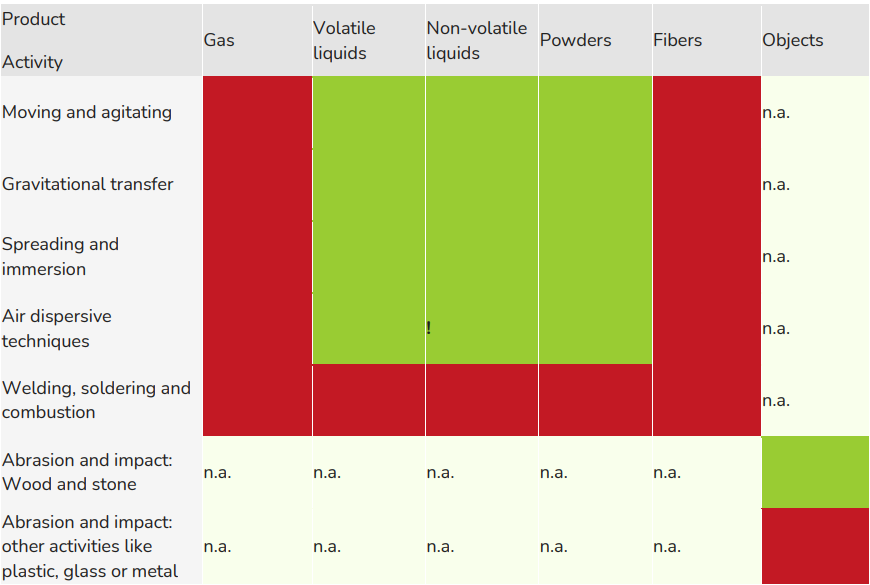
What is Stoffenmanager®?
Background
Stoffenmanager® is validated based on more than 7000 measurements and is (inter)nationally recognised by local governments and the EU. With Stoffenmanager®, you run through the four steps of the Self-inspection Tool Hazardous Substances of the Dutch Ministry SZW. Stoffenmanager® is mentioned in the REACH R.14 Guidance of the European Chemicals Agency (ECHA, August 2016): "Table R14-13: Domain of reliable application of Stoffenmanager® (the algorithms can only be found at www.stoffenmanager.com in its most recent version)".
Although Stoffenmanager® can be applied worldwide, the developers can only guarantee that changes in EU and/or Dutch legislation will be taken into account in the development of the tool. Outside the EU, it is the user's responsibility to check if local legislation accepts the use of Stoffenmanager®.
Validation
Stoffenmanager® develops continuously. Not only are functionalities improved or extended, but also the underlying algorithms.
Prioritisation
Stoffenmanager® version 7.0 and later classifies the hazards of a product based on the H-phrases as described in Arnone et al (2015). The classification in earlier versions was based on COSHH Essentials.
The inhalation exposure model of Stoffenmanager® is based on the source-receptor approach of Cherrie and Schneider (1999) and Marquart et al (2008) (version 3.5)). Subsequent modifications to the model are available to authorities and scientific partners under a non-disclosure agreement. The model for estimating skin exposure is based on the RISKOFDERM Toolkit (Goede et al (2003).
Assessment
The quantification of the inhalation exposure model of Stoffenmanager® version 3.0 and 3.5 is described in Tielemans et al (2008). A further refinement of the model (Stoffenmanager® version 4.0) based on about 1000 measurements is published in Schinkel et al (2010). The authors conclude that the 90-percentile estimate is sufficiently conservative.
Subsequent versions of Stoffenmanager® were further validated and/or compared with other tools in various studies. Meanwhile the validation of the tool is based on more than 7000 measurements. From these studies it can be concluded that Stoffenmanager® is the most balanced, robust and sufficiently conservative tool. With the exception that the exposure to low volatile compounds, released as a result of spraying activities taking place outside without local exhaust ventilation (aerosol formation - PROC11), might be underestimated Tongeren van et al (2017).
Scope
- Green: Exposure to inhalable dust (powders, abrasion wood/stone) and respirable dust (solely abrasion stone) can be assessed in Stoffenmanager®
- Red: Not within the applicability domain of Stoffenmanager®
- N.a.: Not applicable, this situation cannot occur
- !: Exposure to low volatile substances, released from spraying activities outdoors without local exhaust ventilation (aerosol formation - PROC7 and PROC11; ‘Handling of liquids at high pressure resulting in substantial generation of mist or spray/haze’), is possibly underestimated (based on Tongeren van et al (2017). For such activities it is recommended to use the 95-percentile estimation or to comply with an RCR = 0.5 (instead of RCR= 1).
Additional guidance is given in REACH R.14 Guidance (A.14-1.4.1.1. Applicability domain). Here, PROCs are listed that can NOT be used in Stoffenmanager®. Modifications in the models are available to authorities and scientific partners under a non-disclosure agreement.
References
Arnone, M., Koppisch, D., Smola, T., Gabriel, S., Verbist, K., & Visser, R. (2015). Hazard banding in compliance with the new Globally Harmonised System (GHS) for use in control banding tools. Regulatory Toxicology and Pharmacology, 73(1), 287–295. https://doi.org/10.1016/j.yrtph.2015.07.014
Cherrie, J.W., Schneider, T. (1999). Validation of a New Method for Structured Subjective Assessment of Past Concentrations. The Annals of Occupational Hygiene, 43(4), 235-245.
https://doi.org/10.1093/annhyg/43.4.235
Cherrie, J. W., Fransman, W., Heussen, G. A. H., Koppisch, D., & Jensen, K. A. (2020). Exposure Models for REACH and Occupational Safety and Health Regulations. International Journal of Environmental Research and Public Health, 17(2), 383.
https://doi.org/10.3390/ijerph17020383
Van Duuren-Stuurman, B., Vink, S. R., Verbist, K. J. M., Heussen, H. G. A., Brouwer, D. H., Kroese, D. E. D., Van Niftrik, M. F. J., Tielemans, E., Fransman, W. (2012). Stoffenmanager Nano Version 1.0: A Web-Based Tool for Risk Prioritization of Airborne Manufactured Nano Objects, The Annals of Occupational Hygiene, 56(5), 525–541.
https://doi.org/10.1093/annhyg/mer113
Fransman, W., Arnone, M., Borghi, F., Cattaneo, A., Cavallo, D. M., Cherrie, J. W., Franken, R., Galea, K. S., van der Haar, R., Heussen, G. A. H., Jensen, K. A., Koponen, M., Koppisch, D., Kromhout, H., Luo, Y. S., McNally, K., Säämänen, A., Spinazzè, A., van Tongeren, M., Vanoirbeek, J., Verpaele, S., Vetter, D., Viegas, S., Warren, N. (2022). Response Letter to Koivistoet et al. ‘Evaluating the Theoretical Background of STOFFENMANAGER® and the Advanced REACH Tool’. Annals of Work Exposures and Health, 66(4), 543–549.
https://doi.org/10.1093/annweh/wxac001
Goede, H. A., Tijssen, S. C. H. A., Schipper, H. J., Warren, N., Oppl, R., Kalberlah, F., Van Hemmen, J. J. (2003). Classification of Dermal Exposure Modifiers and Assignment of Values for a Risk Assessment Toolkit, The Annals of Occupational Hygiene, 47(8), 609–618. https://doi.org/10.1093/annhyg/meg070
Heussen, H., Hollander, A., Verbist, K. (2020). Stoffenmanager® preventie platfor- Op weg naar een persoonlijk blootstellingsdossier gevaarlijke stoffen, Tijdschrift voor Toegepaste Arbowetenschap, 33(3), 104-112.
TtA 2020-03 def.pdf (arbeidshygiene.nl)
Huang, S., & Wu, K. (2019). Health Risk Assessment of Photoresists Used in an Optoelectronic Semiconductor Factory. Risk Analysis, 39(12), 2625–2639.
https://doi.org/10.1111/risa.13366
Huang, S. Z., Chuang, Y. C., Hung, P. C., Chen, C. Y., Chiang, S. Y., & Wu, K. Y. (2020). Incorporating Exposure Measurement Data from Similar Exposure Scenarios to Inform Exposure Modeling Estimates: A Demonstration Using Cluster Analysis and Bayesian Modeling. Annals of Work Exposures and Health, 65(1), 96–112.
https://doi.org/10.1093/annweh/wxaa088
Jankowska, A., Czerczak, S., Kucharska, M., Wesołowski, W., Maciaszek, P., & Kupczewska-Dobecka, M. (2015). Application of predictive models for estimation of health care workers exposure to sevoflurane. International Journal of Occupational Safety and Ergonomics, 21(4), 471–479. https://doi.org/10.1080/10803548.2015.1086183
Koppisch, D., Schinkel, J., Gabriel, S., Fransman, W., Tielemans, E. (2012). Use of the MEGA Exposure Database for the Validation of the Stoffenmanager Model, The Annals of Occupational Hygiene, 56(4), 426–439.
https://doi.org/10.1093/annhyg/mer097
Lamb, J., Galea, K. S., Miller, B. G., Hesse, S., & Van Tongeren, M. (2017). Between-User Reliability of Tier 1 Exposure Assessment Tools Used Under REACH. Annals of Work Exposures and Health, 61(8), 939–953.
https://doi.org/10.1093/annweh/wxx074
Landberg, H. E., Berg, P., Andersson, L., Bergendorf, U., Karlsson, J. E., Westberg, H., & Tinnerberg, H. (2015b). Comparison and Evaluation of Multiple Users’ Usage of the Exposure and Risk Tool: Stoffenmanager 5.1. Annals of Occupational Hygiene, 59(7), 821–835. https://doi.org/10.1093/annhyg/mev027
Landberg, H. E., Axmon, A., Westberg, H., & Tinnerberg, H. (2017). A Study of the Validity of Two Exposure Assessment Tools: Stoffenmanager and the Advanced REACH Tool. Annals of Work Exposures and Health, 61(5), 575–588.
https://doi.org/10.1093/annweh/wxx008
Landberg, H. (2018). The Use of Exposure Models in Assessing Occupational Exposure to Chemicals. [Doctoral Thesis (compilation), Department of Laboratory Medicine]. Lund University: Faculty of Medicine.
https://lucris.lub.lu.se/ws/portalfiles/portal/37105703/Kappa2017_12_21_a.pdf
Landberg, H. E., Westberg, H., & Tinnerberg, H. (2018). Evaluation of risk assessment approaches of occupational chemical exposures based on models in comparison with measurements. Safety Science, 109, 412–420.
https://doi.org/10.1016/j.ssci.2018.06.006
Lee, E. G., Lamb, J., Savic, N., Basinas, I., Gasic, B., Jung, C., Kashon, M. L., Kim, J., Tischer, M., van Tongeren, M., Vernez, D., & Harper, M. (2018). Evaluation of Exposure Assessment Tools under REACH: Part II—Higher Tier Tools. Annals of Work Exposures and Health, 63(2), 230–241. https://doi.org/10.1093/annweh/wxy098
Lee, S., Lee, K., & Kim, H. (2018). Comparison of Quantitative Exposure Models for Occupational Exposure to Organic Solvents in Korea. Annals of Work Exposures and Health, 63(2), 197–217.
https://doi.org/10.1093/annweh/wxy087
Lee, E. G. (2023). Evaluation of Stoffenmanager® and ART for Estimating Occupational Inhalation Exposures to Volatile Liquids. Annals of Work Exposures and Health.
https://doi.org/10.1093/annweh/wxac091
Marquart, H., Heussen, H., Le Feber, M., Noy, D., Tielemans, E., Schinkel, J., West, J., Van Der Schaaf, D. (2008). ‘Stoffenmanager’, a Web-Based Control Banding Tool Using an Exposure Process Model, The Annals of Occupational Hygiene, 52(6), 429-441. https://doi.org/10.1093/annhyg/men032
Ribalta, C., López-Lilao, A., Estupiñá, S., Fonseca, A., Tobías, A., García-Cobos, A., Minguillón, M., Monfort, E., & Viana, M. (2019). Health risk assessment from exposure to particles during packing in working environments. Science of The Total Environment, 671, 474–487. https://doi.org/10.1016/j.scitotenv.2019.03.347
Ribalta, C., Koivisto, A. J., López-Lilao, A., Estupiñá, S., Minguillón, M. C., Monfort, E., & Viana, M. (2019). Testing the performance of one and two box models as tools for risk assessment of particle exposure during packing of inorganic fertilizer. Science of The Total Environment, 650, 2423–2436.
https://doi.org/10.1016/j.scitotenv.2018.09.379
Riedmann, R. A., Gasic, B., & Vernez, D. (2015). Sensitivity Analysis, Dominant Factors, and Robustness of the ECETOC TRA v3, Stoffenmanager 4.5, and ART 1.5 Occupational Exposure Models. Risk Analysis, 35(2), 211–225.
https://doi.org/10.1111/risa.12286
Schinkel, J., Fransman, W., Heussen, H., Kromhout, H., Marquart, H., & Tielemans, E. (2009). Cross-validation and refinement of the Stoffenmanager as a first tier exposure assessment tool for REACH. Occupational and Environmental Medicine, 67(2), 125–132. https://doi.org/10.1136/oem.2008.045500
Schlüter, U., Arnold, S., Borghi, F., Cherrie, J., Fransman, W., Heussen, H., Jayjock, M., Jensen, K. A., Koivisto, J., Koppisch, D., Meyer, J., Spinazzè, A., Tanarro, C., Verpaele, S., & von Goetz, N. (2022). Theoretical Background of Occupational-Exposure Models—Report of an Expert Workshop of the ISES Europe Working Group “Exposure Models”. International Journal of Environmental Research and Public Health, 19(3), 1234.
https://doi.org/10.3390/ijerph19031234
Spinazzè, A., Lunghini, F., Campagnolo, D., Rovelli, S., Locatelli, M., Cattaneo, A., & Cavallo, D. M. (2017). Accuracy Evaluation of Three Modelling Tools for Occupational Exposure Assessment. Annals of Work Exposures and Health, 61(3), 284–298.
https://doi.org/10.1093/annweh/wxx004
Spinazzè, Borghi, Campagnolo, Rovelli, Keller, Fanti, Cattaneo, & Cavallo. (2019). How to Obtain a Reliable Estimate of Occupational Exposure? Review and Discussion of Models’ Reliability. International Journal of Environmental Research and Public Health, 16(15), 2764. https://doi.org/10.3390/ijerph16152764
Schlüter, U., Meyer, J., Ahrens, A., Borghi, F., Clerc, F., Delmaar, C., Di Guardo, A., Dudzina, T., Fantke, P., Fransman, W., Hahn, S., Heussen, H., Jung, C., Koivisto, J., Koppisch, D., Paini, A., Savic, N., Spinazzè, A., Zare Jeddi, M., & von Goetz, N. (2022). Exposure modelling in Europe: how to pave the road for the future as part of the European Exposure Science Strategy 2020–2030. Journal of Exposure Science & Environmental Epidemiology, 32(4), 499–512.
https://doi.org/10.1038/s41370-022-00455-4
Tielemans, E., Noy, D., Schinkel, J., Heussen, H., Van Der Schaaf, D., West, J., Fransman, W. (2008). Stoffenmanager Exposure Model: Development of a Quantitative Algorithm, The Annals of Occupational Hygiene, 52(6), 443–454.
https://doi.org/10.1093/annhyg/men033
Tielemans, E., Schneider, T., Goede, H., Tischer, M., Warren, N., Kromhout, H., Van Tongeren, M., Van Hemmen, J., Cherrie, J. W. (2008). Conceptual Model for Assessment of Inhalation Exposure: Defining Modifying Factors, The Annals of Occupational Hygiene, 52(7),577–586. https://doi.org/10.1093/annhyg/men059
van Tongeren, M., Lamb, J., Cherrie, J. W., MacCalman, L., Basinas, I., & Hesse, S. (2017). Validation of Lower Tier Exposure Tools Used for REACH: Comparison of Tools Estimates With Available Exposure Measurements. Annals of Work Exposures and Health, 61(8), 921–938. https://doi.org/10.1093/annweh/wxx056
Stoffenmanager® for smart chemicals management and business continuity - OSHWiki. (z.d.).
Verbist, K., Marquart, H., Heussen, H., Schinkel, J., West, J., Fransman, W., van Niftrik, M., Tielemans, E. (2011). Stoffenmanager: een web-based control banding tool, Tijdschrift voor toegepaste Arbowetenschap, 3, 92-104.
https://www.arbeidshygiene.nl/-uploads/files/insite/2011-03-full-paper-verbist.pdf
Vink, S., Mikkers, J., Bouwman, T., Marquart, H., & Kroese, E. (2010). Use of read-across and tiered exposure assessment in risk assessment under REACH – A case study on a phase-in substance. Regulatory Toxicology and Pharmacology, 58(1), 64–71. https://doi.org/10.1016/j.yrtph.2010.04.004
Zalk, D. M., & Nelson, D. I. (2008). History and Evolution of Control Banding: A Review. Journal of Occupational and Environmental Hygiene, 5(5), 330–346.
https://doi.org/10.1080/15459620801997916
Zalk, D. M., & Heussen, G. H. (2011). Banding the World Together; The Global Growth of Control Banding and Qualitative Occupational Risk Management. Safety and Health at Work, 2(4), 375–379.
https://doi.org/10.5491/shaw.2011.2.4.3752). https://doi.org/10.1038/s41370-022-00455-4
